Abstract
A model of intracellular growth for Legionella pneumophila in Acanthamoeba castellanii has been developed and provides a quantitative measure of survival and replication after entry. In this model, Acanthamoeba monolayers were incubated with bacteria in tissue culture plates under nutrient-limiting conditions. Gentamicin was used to kill extracellular bacteria following the period of incubation, and the number of intracellular bacteria was determined following lysis of amebae. Intracellular growth of virulent L. pneumophila and other wild-type Legionella species was observed when the assay was performed at 37 degrees C. At room temperature, none of the Legionella strains tested grew intracellularly, while an avirulent L. pneumophila strain was unable to replicate in this assay at either temperature. The effect of nutrient limitation on A. castellanii during the assay prevented multiplication of the amebae and increased the level of infection by Legionella spp. The level of infection of the amebae was directly proportional to the multiplicity of infection with bacteria; at an inoculum of 1.03 x 10(7) bacteria added to wells containing 1.10 x 10(5) amebae (multiplicity of infection of 100), approximately 4.4% of A. castellanii cells became infected. Cytochalasin D reduced the uptake of bacteria by the amebae primarily by causing amebae to lift off the culture dish, reducing the number of target hosts; methylamine also reduced the level of initial infection, yet neither inhibitor was able to prevent intracellular replication of Legionella spp. Consequently, once the bacteria entered the cell, only lowered temperature could restrict replication. This model of intracellular growth provides a one-step growth curve and should be useful to study the molecular basis of the host-parasite interaction.
Full text
PDF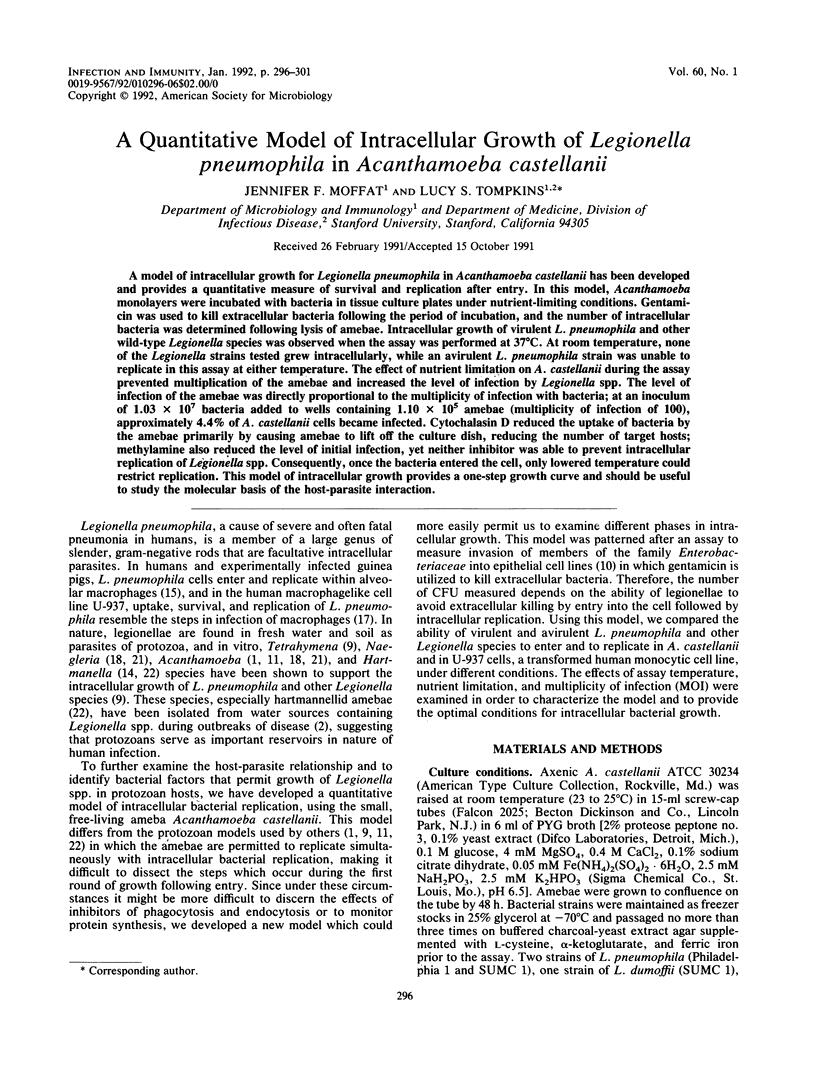
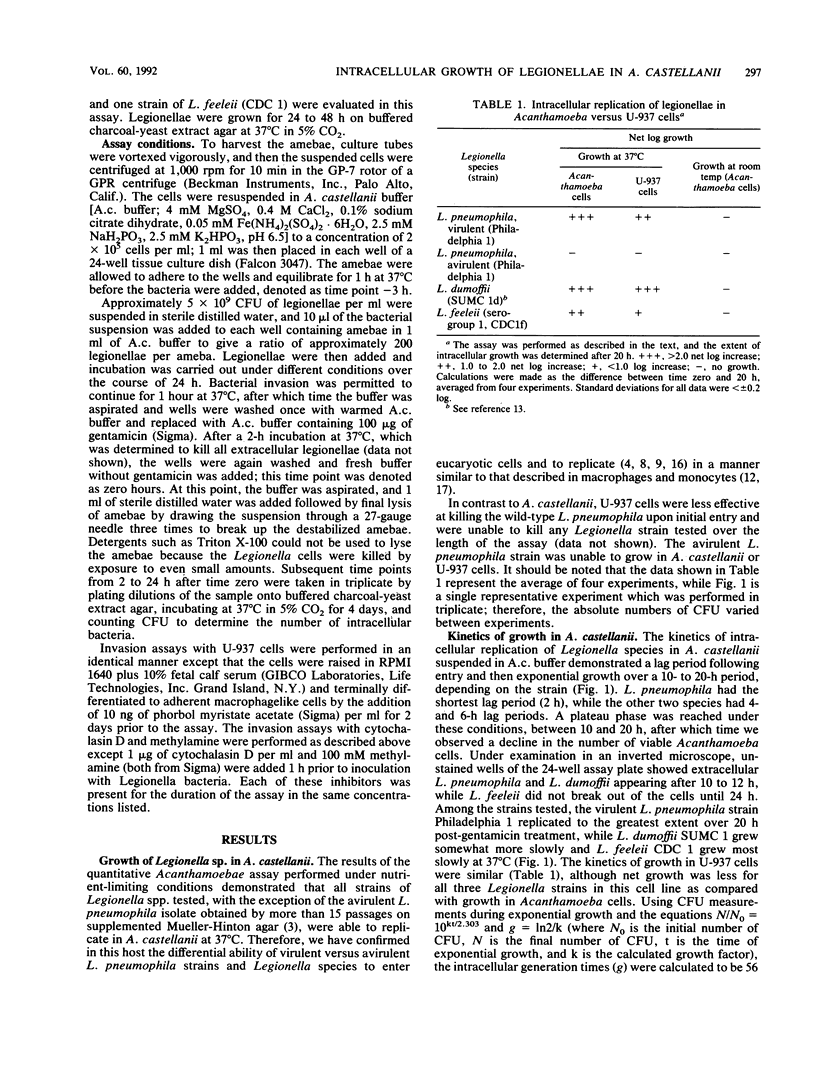
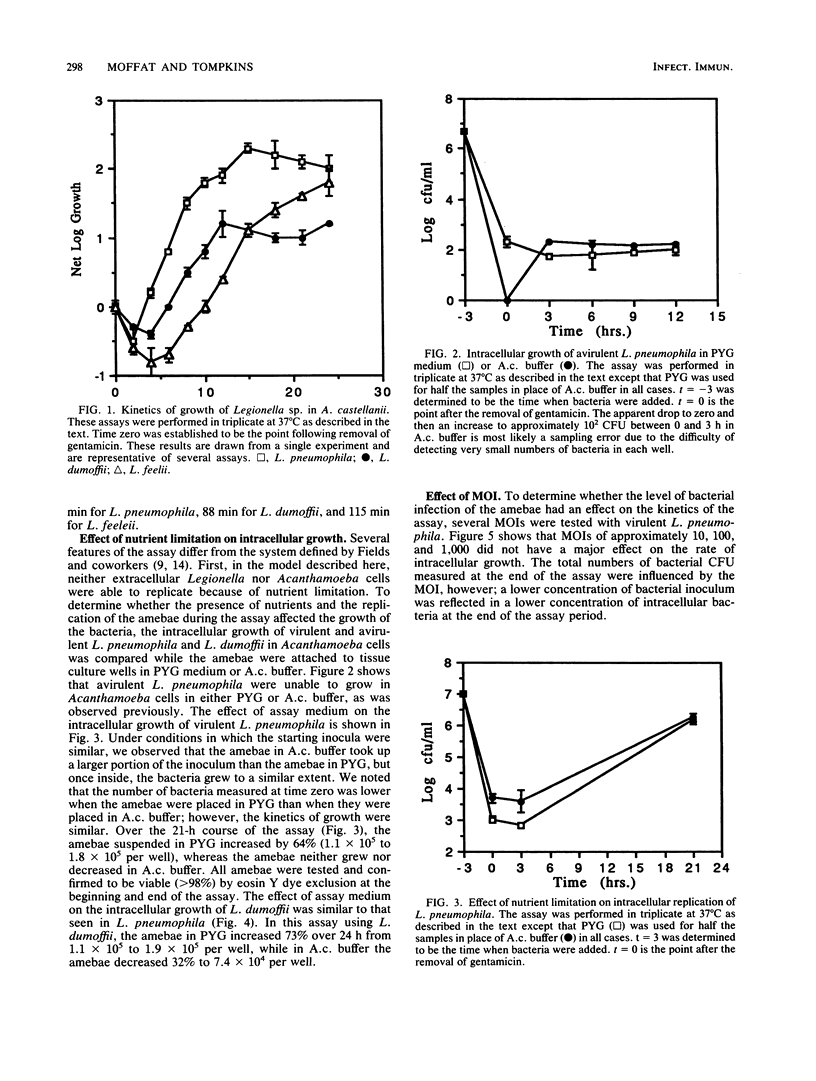
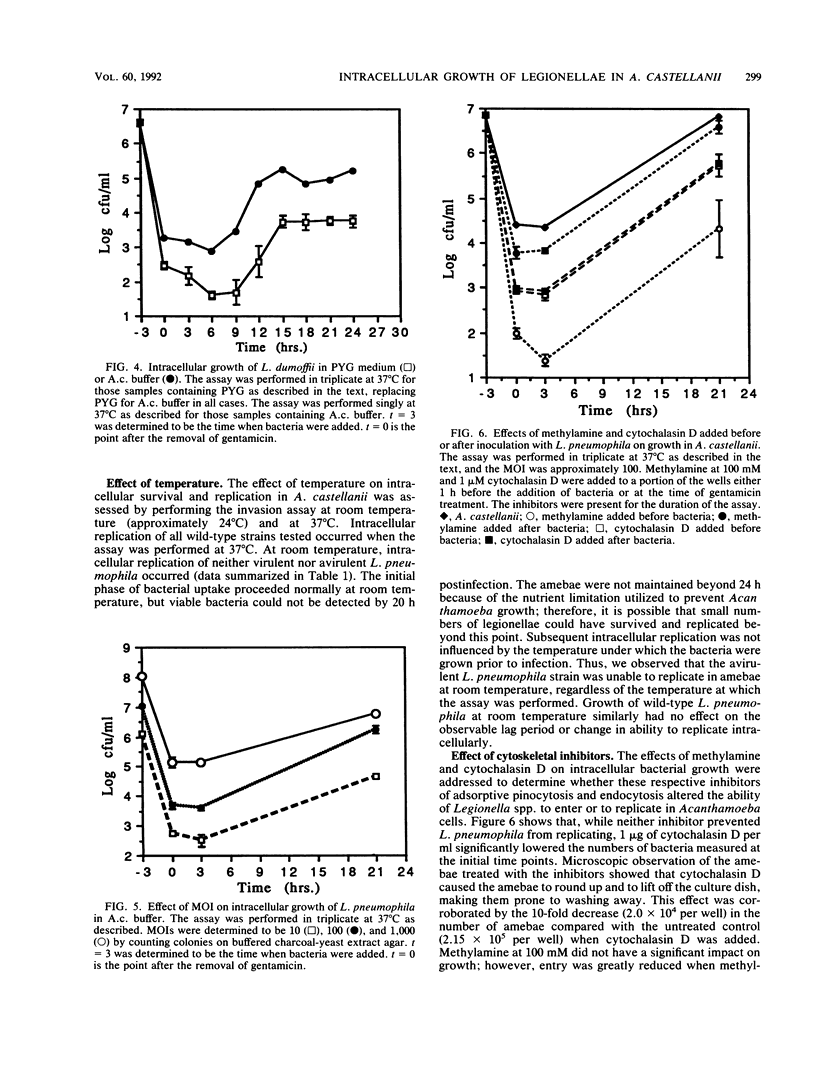
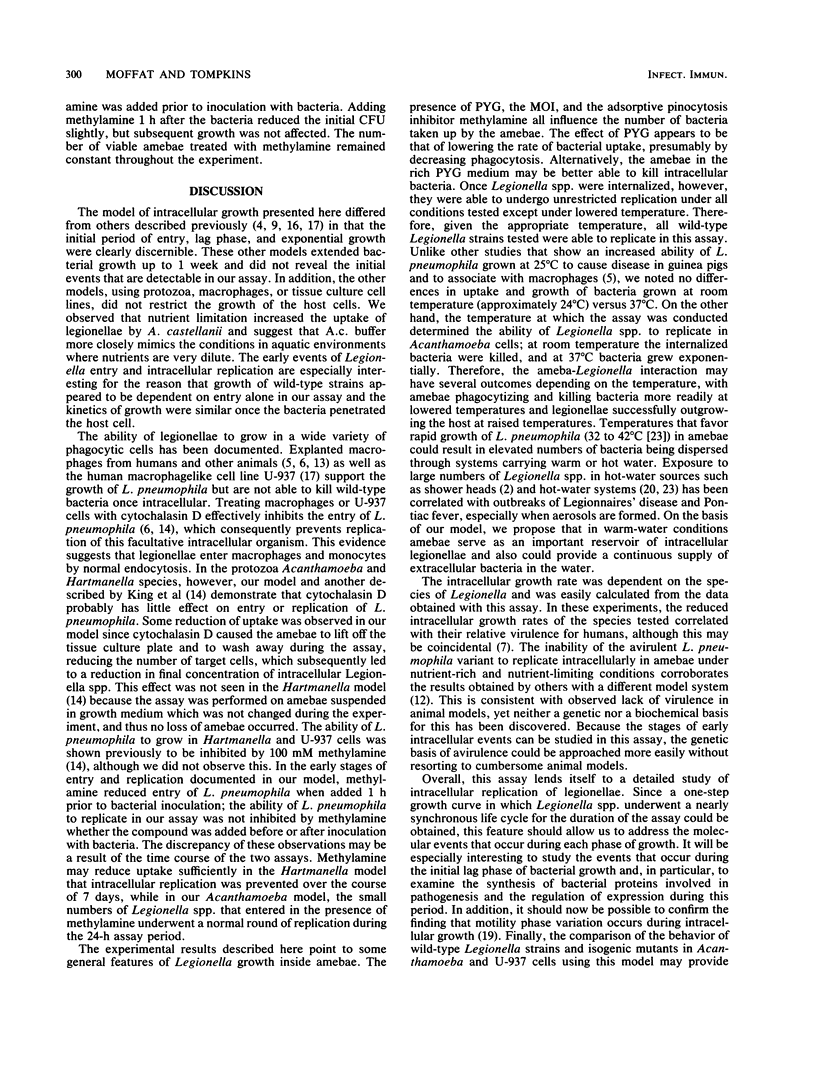
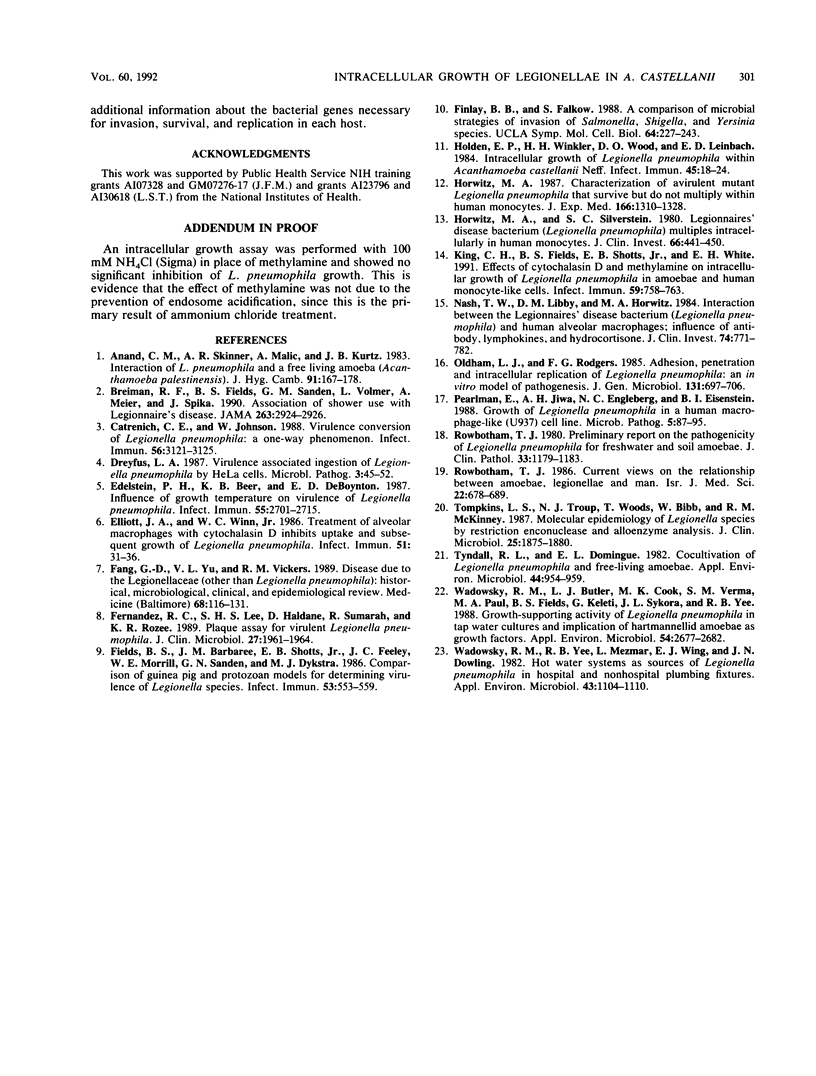
Selected References
These references are in PubMed. This may not be the complete list of references from this article.
- Anand C. M., Skinner A. R., Malic A., Kurtz J. B. Interaction of L. pneumophilia and a free living amoeba (Acanthamoeba palestinensis). J Hyg (Lond) 1983 Oct;91(2):167–178. doi: 10.1017/s0022172400060174. [DOI] [PMC free article] [PubMed] [Google Scholar]
- Breiman R. F., Fields B. S., Sanden G. N., Volmer L., Meier A., Spika J. S. Association of shower use with Legionnaires' disease. Possible role of amoebae. JAMA. 1990 Jun 6;263(21):2924–2926. [PubMed] [Google Scholar]
- Catrenich C. E., Johnson W. Virulence conversion of Legionella pneumophila: a one-way phenomenon. Infect Immun. 1988 Dec;56(12):3121–3125. doi: 10.1128/iai.56.12.3121-3125.1988. [DOI] [PMC free article] [PubMed] [Google Scholar]
- Dreyfus L. A. Virulence associated ingestion of Legionella pneumophila by HeLa cells. Microb Pathog. 1987 Jul;3(1):45–52. doi: 10.1016/0882-4010(87)90036-2. [DOI] [PubMed] [Google Scholar]
- Edelstein P. H., Beer K. B., DeBoynton E. D. Influence of growth temperature on virulence of Legionella pneumophila. Infect Immun. 1987 Nov;55(11):2701–2705. doi: 10.1128/iai.55.11.2701-2705.1987. [DOI] [PMC free article] [PubMed] [Google Scholar]
- Elliott J. A., Winn W. C., Jr Treatment of alveolar macrophages with cytochalasin D inhibits uptake and subsequent growth of Legionella pneumophila. Infect Immun. 1986 Jan;51(1):31–36. doi: 10.1128/iai.51.1.31-36.1986. [DOI] [PMC free article] [PubMed] [Google Scholar]
- Fang G. D., Yu V. L., Vickers R. M. Disease due to the Legionellaceae (other than Legionella pneumophila). Historical, microbiological, clinical, and epidemiological review. Medicine (Baltimore) 1989 Mar;68(2):116–132. doi: 10.1097/00005792-198903000-00005. [DOI] [PubMed] [Google Scholar]
- Fernandez R. C., Lee S. H., Haldane D., Sumarah R., Rozee K. R. Plaque assay for virulent Legionella pneumophila. J Clin Microbiol. 1989 Sep;27(9):1961–1964. doi: 10.1128/jcm.27.9.1961-1964.1989. [DOI] [PMC free article] [PubMed] [Google Scholar]
- Fields B. S., Barbaree J. M., Shotts E. B., Jr, Feeley J. C., Morrill W. E., Sanden G. N., Dykstra M. J. Comparison of guinea pig and protozoan models for determining virulence of Legionella species. Infect Immun. 1986 Sep;53(3):553–559. doi: 10.1128/iai.53.3.553-559.1986. [DOI] [PMC free article] [PubMed] [Google Scholar]
- Holden E. P., Winkler H. H., Wood D. O., Leinbach E. D. Intracellular growth of Legionella pneumophila within Acanthamoeba castellanii Neff. Infect Immun. 1984 Jul;45(1):18–24. doi: 10.1128/iai.45.1.18-24.1984. [DOI] [PMC free article] [PubMed] [Google Scholar]
- Horwitz M. A. Characterization of avirulent mutant Legionella pneumophila that survive but do not multiply within human monocytes. J Exp Med. 1987 Nov 1;166(5):1310–1328. doi: 10.1084/jem.166.5.1310. [DOI] [PMC free article] [PubMed] [Google Scholar]
- Horwitz M. A., Silverstein S. C. Legionnaires' disease bacterium (Legionella pneumophila) multiples intracellularly in human monocytes. J Clin Invest. 1980 Sep;66(3):441–450. doi: 10.1172/JCI109874. [DOI] [PMC free article] [PubMed] [Google Scholar]
- King C. H., Fields B. S., Shotts E. B., Jr, White E. H. Effects of cytochalasin D and methylamine on intracellular growth of Legionella pneumophila in amoebae and human monocyte-like cells. Infect Immun. 1991 Mar;59(3):758–763. doi: 10.1128/iai.59.3.758-763.1991. [DOI] [PMC free article] [PubMed] [Google Scholar]
- Nash T. W., Libby D. M., Horwitz M. A. Interaction between the legionnaires' disease bacterium (Legionella pneumophila) and human alveolar macrophages. Influence of antibody, lymphokines, and hydrocortisone. J Clin Invest. 1984 Sep;74(3):771–782. doi: 10.1172/JCI111493. [DOI] [PMC free article] [PubMed] [Google Scholar]
- Oldham L. J., Rodgers F. G. Adhesion, penetration and intracellular replication of Legionella pneumophila: an in vitro model of pathogenesis. J Gen Microbiol. 1985 Apr;131(4):697–706. doi: 10.1099/00221287-131-4-697. [DOI] [PubMed] [Google Scholar]
- Pearlman E., Jiwa A. H., Engleberg N. C., Eisenstein B. I. Growth of Legionella pneumophila in a human macrophage-like (U937) cell line. Microb Pathog. 1988 Aug;5(2):87–95. doi: 10.1016/0882-4010(88)90011-3. [DOI] [PubMed] [Google Scholar]
- Rowbotham T. J. Current views on the relationships between amoebae, legionellae and man. Isr J Med Sci. 1986 Sep;22(9):678–689. [PubMed] [Google Scholar]
- Rowbotham T. J. Preliminary report on the pathogenicity of Legionella pneumophila for freshwater and soil amoebae. J Clin Pathol. 1980 Dec;33(12):1179–1183. doi: 10.1136/jcp.33.12.1179. [DOI] [PMC free article] [PubMed] [Google Scholar]
- Tompkins L. S., Troup N. J., Woods T., Bibb W., McKinney R. M. Molecular epidemiology of Legionella species by restriction endonuclease and alloenzyme analysis. J Clin Microbiol. 1987 Oct;25(10):1875–1880. doi: 10.1128/jcm.25.10.1875-1880.1987. [DOI] [PMC free article] [PubMed] [Google Scholar]
- Tyndall R. L., Domingue E. L. Cocultivation of Legionella pneumophila and free-living amoebae. Appl Environ Microbiol. 1982 Oct;44(4):954–959. doi: 10.1128/aem.44.4.954-959.1982. [DOI] [PMC free article] [PubMed] [Google Scholar]
- Wadowsky R. M., Butler L. J., Cook M. K., Verma S. M., Paul M. A., Fields B. S., Keleti G., Sykora J. L., Yee R. B. Growth-supporting activity for Legionella pneumophila in tap water cultures and implication of hartmannellid amoebae as growth factors. Appl Environ Microbiol. 1988 Nov;54(11):2677–2682. doi: 10.1128/aem.54.11.2677-2682.1988. [DOI] [PMC free article] [PubMed] [Google Scholar]
- Wadowsky R. M., Yee R. B., Mezmar L., Wing E. J., Dowling J. N. Hot water systems as sources of Legionella pneumophila in hospital and nonhospital plumbing fixtures. Appl Environ Microbiol. 1982 May;43(5):1104–1110. doi: 10.1128/aem.43.5.1104-1110.1982. [DOI] [PMC free article] [PubMed] [Google Scholar]


